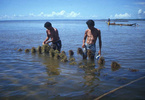red algae
RhodophytaIntroduction 5
The Rhodophyta (red algae) are a distinct eukaryotic lineage characterized by the accessory photosynthetic pigments phycoerythrin, phycocyanin and allophycocyanins arranged in phycobilisomes, and the absence of flagella and centrioles (Woelkerling 1990). This is a large assemblage of between 2500 and 6000 species in about 670 largely marine genera (Woelkerling 1990) that predominate along the coastal and continental shelf areas of tropical, temperate and cold-water regions (Lüning 1990). Red algae are ecologically significant as primary producers, providers of structural habitat for other marine organisms, and their important role in the primary establishment and maintenance of coral reefs. Some red algae are economically important as providers of food and gels. For this reason, extensive farming and natural harvest of red algae occurs in numerous areas of the world. 
Figure 1. Seaweed farmers tending a Kappaphycus line culture in the Philippines.
Kappaphycus and other Gigartinales species are grown commercially for the extraction of carrageenan, a gel used in many food products.
Image copyright © 2000, D. F. Kapraun.
Sources and Credits
- (c) Bernard Picton, some rights reserved (CC BY-NC-SA), http://www.habitas.org.uk/marinelife/algae/F11628.jpg
- (c) D.S. Littler, some rights reserved (CC BY-NC-SA), https://collections.nmnh.si.edu/services/media.php?env=botany&irn=10505015
- (c) Bernard Picton, some rights reserved (CC BY-NC-SA), http://www.habitas.org.uk/marinelife/algae/sciint.jpg
- (c) Bernard Picton, some rights reserved (CC BY-NC-SA), http://www.habitas.org.uk/marinelife/algae/gellat.jpg
- (c) <a href="http://tolweb.org/people/662">D. Wilson Freshwater</a>, some rights reserved (CC BY), http://eol.org/data_objects/10108276









